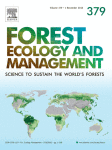Ver ítem
- xmlui.general.dspace_homeCentros Regionales y EEAsCentro Regional Patagonia NorteEEA BarilocheArtículos científicosxmlui.ArtifactBrowser.ItemViewer.trail
- Inicio
- Centros Regionales y EEAs
- Centro Regional Patagonia Norte
- EEA Bariloche
- Artículos científicos
- Ver ítem
Differentiation in phenology among and within natural populations of a South American Nothofagus revealed by a two-year evaluation in a common garden trial
Resumen
Phenological traits are crucial for understanding adaptation to climate change due to their genetic control and association with abiotic factors. However, few data on phenology patterns are available for South American Nothofagus species, in particular for Nothofagus alpina, a key species of the temperate forests of Patagonia. Therefore, our aim was to analyze the variation among and within natural populations of N. alpina in two phenological traits (bud
[ver mas...]
Phenological traits are crucial for understanding adaptation to climate change due to their genetic control and association with abiotic factors. However, few data on phenology patterns are available for South American Nothofagus species, in particular for Nothofagus alpina, a key species of the temperate forests of Patagonia. Therefore, our aim was to analyze the variation among and within natural populations of N. alpina in two phenological traits (bud burst and foliar senescence), in growing season length and in relative growth height. We registered phenology in 65 open pollinated families of eight Argentinean natural populations installed in a common garden trial. Apical buds and foliar senescence were observed every three days in 6-year-old plants and again three years later in the same plants (N = 373). Day of the year until bud burst (DOY) and until the beginning (DOY10) and the end (DOY90) of foliar senescence were measured. Height was measured twice in a year in order to calculate the annual growth in both seasons. Growing degree days (GDD) and chilling hours (CH) until bud burst were also calculated, with two possible basal temperatures (5 °C and 7 °C) to evaluate their role in DOY. Significant differences among populations and years in DOY and growing season length were found using a linear mixed model (LMM), with the family factor explaining around 30% and 12% of the total variance respectively.
The LMM for foliar senescence (DOY10 and DOY90) and the relative growth height (RGH) showed significant differences between years but not among populations. The family factor was significant for foliar senescence, although it only explained a small part of the total variance (DOY10: 4%; DOY90: 2%) and was not significant for relative growth height. A tight relationship between GDD and CH with DOY was found, and LMM showed significant differences among populations and years for both variables. The correlation between the altitude of natural populations and the mean DOY and GDD was high and positive. Our results reveal (i) the genetic control of bud burst and foliar senescence, and phenotypic plasticity of all analyzed traits, (ii) that GDD and CH are implicated in the DOY, and (iii) that altitude is probably conditioning thermal requirement of bud burst. This information suggests good perspectives to face the climate change scenario and highlight the importance of selecting appropriate populations and families for domestication and breeding of N. alpina at particular sites.
[Cerrar]

Fuente
Forest Ecology and Management 460 : 117858 (March 2020)
Fecha
2020-03-15
Editorial
Elsevier
ISSN
0378-1127
Formato
pdf
Tipo de documento
artículo
Palabras Claves
Derechos de acceso
Restringido
 Excepto donde se diga explicitamente, este item se publica bajo la siguiente descripción: Creative Commons Attribution-NonCommercial-ShareAlike 2.5 Unported (CC BY-NC-SA 2.5)
Excepto donde se diga explicitamente, este item se publica bajo la siguiente descripción: Creative Commons Attribution-NonCommercial-ShareAlike 2.5 Unported (CC BY-NC-SA 2.5)

